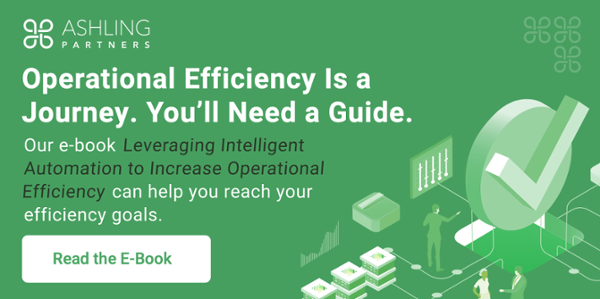To achieve operational efficiency, organizations must improve their processes and workflows. Many of these processes include lots of documents. You may need to extract, interpret, or process data in a variety of formats—text documents, PDFs, images, handwritten scans, and more. How can you easily do this by using software robots versus human labor? The answer is document understanding, which is key to meeting operational efficiency goals.
In this post, we’ll define document processing, explore how to implement it, and highlight some of the ways it drives operational efficiency.
What Is Document Understanding?
Document understanding describes the effort by computer software robots to intake, process, and extract information from unstructured files such as PDFs, images, and more. True understanding occurs when the robot can open a file, identify the type of file, and then successfully extract the key fields. The bots then enter those values into downstream applications or databases.
The technology behind document understanding marries robotic process automation (RPA) and artificial intelligence (AI). When combined, the process becomes intelligent automation, extricating data from different document types and interpreting it as needed.
Document Understanding: A Solution for All Data Types
Document understanding can apply to structured and unstructured data. Structured data is much easier because it contains tags that identify text fields and document attributes. Examples include HTML or XML formats.
Unstructured data is more complex and often requires manual labor. Unstructured data describes anything in a format not suitable for computers, as content is in a free format. Examples include contracts, letters, articles, and memos. An estimate from IDC says that about 80 percent of data will be in this format by 2025.
There is also a third category: semi-structured data, which is a mix of the other two. Examples of semi-structured documents include invoices, purchase orders, bills of lading, and explanations of benefits.
Unstructured and semi-structured data present challenges for companies because of the manual work necessary to use the data. Conquering this problematic aspect of data processing is a big part of how document understanding supports operational efficiency.
The process teaches automated software bots how to read and understand documents. Once trained, they’ll tackle all the heavy lifting, eliminating the need for human intervention.
How Does Document Understanding Work?
Using this type of automation tool doesn’t have to be complicated. The first step is training your robots on many samples so they learn quickly and thoroughly. Investing in this training up front will save so much time in the future.
You can implement document understanding with just a few steps:
- Define the files and data for extraction.
- Digitize them and use optical character recognition (OCR) to detect text locations.
- Classify the documents.
- Extract information from the documents.
- Validate extracted data, if needed.
- Export the data for future usage.
What Are the Features and Use Cases for Document Understanding?
There are several specific ways to leverage document understanding:
- Use pre-built or custom models to build end-to-end workflow automations.
- Extract data from documents based on rules, anchors, or intelligent templates with no-code AI.
- Process structured and semi-structured data with minimal setup required.
- Augment robots with human validation when they flag something, triggering a notification.
- Retrain machine learning models to get more specific around your document.
The functionality document understanding enables covers many types of tasks. It can help with accounting, for example, with invoices, reconciliation, purchase order validation, and financial statements.
Other use cases involve industries that are document-heavy. Document understanding can support account setup, such as underwriting for mortgages. It could also be useful for insurance companies to gather information from multiple sources for claim adjudication.
What Are the Benefits of Document Understanding?
Document understanding is an operational efficiency enabler across the enterprise. These are some of the benefits you can realize from deploying it:
- Streamline workflows because it’s versatile enough to use on any document type.
- Eliminate errors from manual processing as software robots get more accurate over time.
- Reduce complexity with end-to-end automation of processes, which are often time-consuming and inefficient.
- Use data more effectively. Document processing does more than copy and paste; it aggregates data and places it in new formats.
- Save money because processing takes less time and requires less labor.
- Standardize processes to simplify workflows that may be bloated and have many barriers due to the dependence on human labor.
- Optimize processes, transforming the inefficient into something faster and driving greater productivity.
- Remove manual administrative work from employees’ plates, which can improve their job satisfaction and allow them to focus on higher-value work and be more strategic versus just transactional.
- Scale it for documents of the same type, employing it throughout your organization.
All these benefits align to operational efficiencies. No matter your industry or department, document understanding applies to any process in which data needs to be extracted, validated, and reformatted. With software bots doing this labor-intensive work, you can quickly make strides in accelerating efficiency.
To learn more about automation and operational efficiency, read our new e-book, Leveraging Intelligent Automation to Increase Operational Efficiency.



